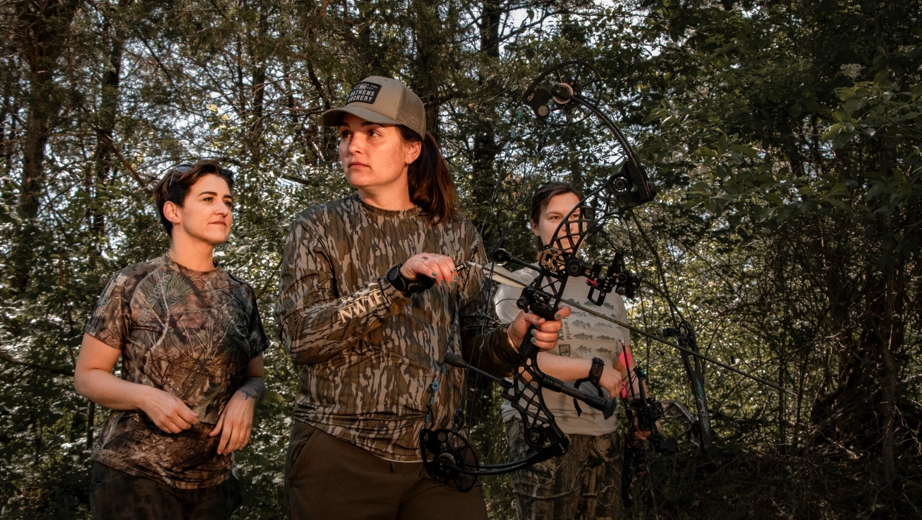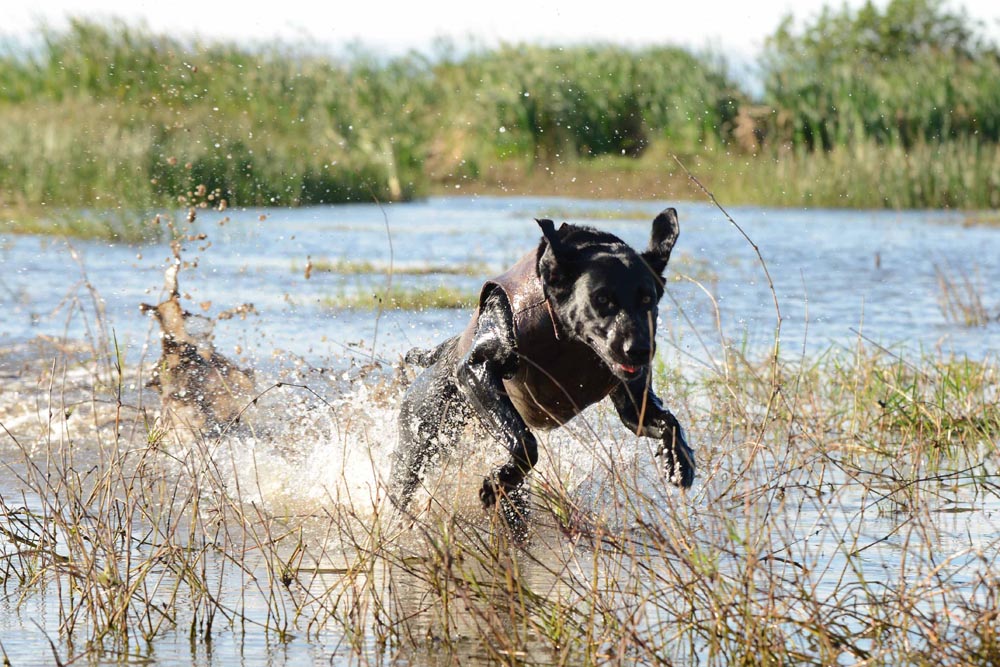Organization-Wide Buy-In
What is it?
Many organizations are structured to consolidate particular areas of expertise into divisions, sections, and departments. Unfortunately, this “siloing” can create difficulties for R3 practitioners who often need buy-in and support from various departments across their organization to effectively and efficiently implement R3 efforts. Thus, organization-wide buy-in is essential for R3 practitioners. This is not to say you have to have 100% internal support before you begin R3 work, but building support across your organization is an important early step in the R3 process.
Why is it Important?
Practical experience from R3 practitioners clearly shows that organizational support needed to implement effective R3 efforts goes far beyond that of the R3 Coordinator and their associated staff. It also requires leadership support for funding and staff allocation, marketing and communications expertise, human dimensions insight, license/permit and data management, volunteer/partnership coordination, and many other specialties if it is going to have a significant and lasting impact.
How can your organization help its practitioners?
- Make R3 an organization-wide priority.
- Provide support for an organization-wide, cross-functional team to develop your R3 plan.
- Allow all members of the R3 planning team to spend time working on the R3 plan.
- Support professional development for R3 practitioners.
- Allocate budget for R3 planning team meetings.
- Participate in R3 goal and objective setting.
- Include R3 in onboarding and evaluation for all employees.
- Have R3 staff attend events/meetings in other departments to share R3 activities and priorities.
Setting Up Your Organization for Change

Organizational buy-in begins with a strategic approach that integrates your organization’s R3 goals and objectives and the involvement, insight, and perspective of the staff impacted by the plan–especially those who have the influence and expertise needed to deliver R3 efforts. Broadly, the following steps outline how an R3 practitioner should work toward achieving organizational buy-in:
Begin with understanding your organization’s current R3 efforts, programs, and strategies. Program mapping against the Outdoor Recreation Adoption Model is a valuable tool to visually assess the R3 impact of your organization.
- Assess current hunting and shooting sports participation among the populations your organization serves. For example, review hunting license or shooting range permit purchase reports, previous research from expert groups or institutions, and any participant survey data that may exist within your organization or its partners.
- Identify which staff, expertise, leadership/authorities, and sections/divisions/departments have a vested interest in, or will be impacted by, R3 strategy implementation.
- Conduct a listening session with identified staff to learn about their concerns, perspectives, or ideas relative to R3. Use this information and work with them to craft high-level R3 goals and visions.
- Develop an R3 plan (or at least a strategic guidance document or process) that integrates individuals who can represent the various perspectives, concerns, and wisdom of the staff engaged in the previous step. Allies and champions that may have emerged in the earlier efforts should be prioritized for this work. Identify performance metrics for both the strategic plan and organizational buy-in.
- Create a long-term communication plan for R3 efforts. This allows you to share R3-related accomplishments and progress across the organization. Give staff frequent opportunities to learn about R3 and the organization’s approach to it.
- Develop R3 training opportunities for staff involved directly in R3 and for everyone interested in R3.
The following resources provide additional and more detailed guidance on implementing the above change management process.
Building Internal Buy-In
Facilitators guide for Building Internal Buy-In offered by the Council with Justin Grider and Peter Novotny at the 2023 National R3 Symposium.
Change Management Process (Harvard Business School)
These are the key 5 steps in creating organizational change. A systems thinking approach.
Faction Mapping by Kansas Leadership Center
A template to identify what the key values, loyalties, and perceived losses are among factions engaged in and impacted by your change management process
Mapping R3 Efforts on the Outdoor Recreation Adoption Model
An overview of how to use the ORAM to map R3 efforts. Helps agencies create buy-in by visualizing R3 program and efforts.
Recommendations and Strategic Tools for Effective Angler Recruitment, Retention and Reactivation (R3) Efforts
This program evaluation guide was designed for aquatic educators. However, much is readily transferable to any R3 effort. Provides insights for setting up your organization for change.
Ohio Division of Wildlife Law Operations Changes Charter
This is a sample Wildlife Law Operations Charter from the Ohio Division of Wildlife.
Institutionalizing R3
While it’s obvious that R3 efforts should be a top priority for the R3 team (people with R3 in their job descriptions), true organization-wide adoption is best achieved by institutionalizing R3 rather than making it the sole responsibility of a department or a handful of individuals. Consider how many parts of your organization impact the recruitment, retention, and reactivation of hunters and shooting sports participants, either directly or indirectly. All staff should have a stake in delivering R3.
In addition, how R3 fits into the structure of an organization can significantly affect how it is embraced and ultimately implemented. Following are descriptions of how four state agencies structured R3 in their organization.
Even if your organization is not a state agency, the different implementation styles shown in these examples are still useful to review.
Here are a few other best practices to help you institutionalize R3 in your organization:
Demonstrate to leadership (and then everyone else) how R3 supports your organization’s mission.
- Show management the value of investing in R3 efforts. How can their support now result in more effective R3 efforts later and ultimately pay dividends to the organization?
- Include R3-related responsibilities in every (or nearly every) position in your organization. Specifically include responsibilities and performance metrics on how each position impacts the attraction and satisfaction of hunters and recreational shooting participants. For example:
- How quickly are customer service requests addressed, and how satisfied are customers with their resolution?
- Are parking lots, restrooms, and other amenities in access areas clean, fully stocked, and well-maintained?
- Are websites and apps improved from year to year in both analytics and customer ratings?
- Are conservation officers required to do a number of positive customer contact hours every month?
- Are financial transactions with the public simple and error-free
- Are any errors or disputes resolved quickly and pleasantly?
- Add R3-related questions to the interview process for staff not on the primary R3 team.
- Build R3 into professional development and continuing education opportunities.
- Build R3 into processes and procedures in your organization.
- Build R3 into regular commission/leadership/organization meetings and updates.
- Include R3 in the onboarding process for all new staff, regardless of position.
- Survey new staff on participation in hunting and shooting sports, their desire to learn the activities, or to mentor others.
Everyone in your organization impacts R3, and R3 impacts the financial bottom line for conservation efforts nationwide. Hopefully, this connection will help everyone in your organization recognize how their position is related not only to R3 but also to the continuation of conservation as we know it.
How to Build an R3 Planning Team
Development of an R3 plan requires more expertise, perspective, time, and authority than is held by any one or two R3 practitioners. Thus, individuals across the organization must work together, lending all their expertise to R3 planning efforts.
The size and composition of an R3 Planning Team is dependent upon the type and size of the organization itself. That said, the following are types of expertise that should be considered for representation on an internal R3 planning team:
- Leadership (Organization Director/CEO or Deputy Director/Vice President)
- Information technology
- Law enforcement (primarily for state agencies)
- Conservation education
- Communications, outreach, marketing
- Customer service
- Social science/human dimensions
- Wildlife, fisheries management
- Shooting/archery range management
- Land management (primarily for state agencies or NGOs with habitat branches)
Another thing you should consider when assembling your R3 planning team is who is passionate about and supportive of the effort, and whose support you might need during implementation. It’s much harder for a person to ignore requests for assistance if they were on the team that developed the plan. Staff working in education, communication, and access can support the planning process and become valuable collaborators during implementation.

Keep the team size manageable. If the list grows much beyond 20 individuals, consider breaking them into two groups: a core team to do the heavy lifting and a second advisory group to provide feedback and perspective on the core team’s work. Also, ensure your team members receive approval from their supervisors to formally participate on an R3 team.
Almost as important as the composition of the R3 planning team is the need to keep them on task. Regardless of the tasks a planning team engages in, they should have regular meetings (ideally scheduled and managed by an R3 Coordinator) throughout the planning process. Monthly meetings are common but may be as frequent as weekly when momentum is important. Whatever the interval, regular meetings and communication about progress is important for delivering the plan in a reasonable timeframe.
CAHSS R3 Topic Guide “Organizational Culture”
This resource offers guidance to help organizations build their R3 team and select a coordinator.
CAHSS R3 Topic Guide “Statewide Collaborations”
This resource provides guidance for developing statewide R3 collaborations and building an R3 planning team.
The Council’s YouTube Collection: Building Your R3 Team
These episodes suggest how you can work with parallel experts in your field and partners to break down silos.
Effective R3 Team Structure
R3 is a complex topic that reaches across agency/organization categories and departments. Planning and implementing R3 efforts requires the R3 coordinator to work with a broad range of staff from across the organization. Ideally, the R3 coordinator should be positioned fairly high in the organization’s staffing table. This allows the organization more flexibility as to who they can hire. It also gives the coordinator more authority to engage the staff and resources needed to implement R3 effectively.
Sometimes, organizations have limitations on where they can place the R3 coordinator position. It might be much lower in the staffing table. In such cases, the person hired is likely to be early career with little experience and little authority within the organization. In this situation, the coordinator will probably need much more support from higher-level positions in creating organization-wide buy-in, because they will not be able to “assign” work to others in the same way a higher-level position might. There are examples of both situations within the R3 community, and new R3 coordinators (regardless of where they sit) should reach out to others for advice on how to leverage their position most effectively.
CAHSS R3 Topic Guide “Statewide Collaborations”
This resource provides guidance for staffing as it pertains to statewide R3 collaborations.
How to Deliver Staff Training
It is difficult to gather support and participation from your organization and relevant staff without first giving them a chance to learn the fundamentals of R3 and the role you want them to play. This section presents an outline for a proven R3 training agenda that engages relevant staff and builds support for long-term R3 implementation.
Ideal staff types that most benefit from R3 training include:
- Leadership – CEO/Director and Vice President/Deputy Director. Depending on the nature of your organization, allies on boards or commissions should also be considered, but only with the approval and support of the organization’s Director/CEO.
- Chiefs/managers of sections/departments/divisions that have a vested interest in or will be affected by R3 implementation. For example, in agencies, these positions include Chiefs of Wildlife, Fisheries, Conservation Education, Marketing and Communication, Licensing, Hunter Education, Law Enforcement, Hunting or Shooting Sports Outreach, Human Dimensions/Social Science, Customer Service, Shooting Range Management, and Land Management divisions. In NGOs, these could include department leaders in Hunter or Shooting Sports Outreach, Marketing and Communication, Membership Management, Product Sales, Partnership Liaison, Fundraising, and Habitat/Access Management.
- Key implementation staff within the organization. These are the individuals who will be charged with directing or performing specific actions of an R3 effort or program. Look for these individuals within the organizational divisions listed in the previous steps.
- Consider inviting any skeptics or critics within the organization. It would be helpful to understand the reasons for their opposition. It also provides an opportunity to provide more information and possibly convince them of the importance of the work.
5 Critical Steps In The Change Management Process
This resource covers important considerations in the change management process.
Sample Agenda for R3 Training Meeting
Sample agenda for R3 training meeting incorporating the minimum topics that should be included in an R3 training and organized by ideal learning sequence.
Communicating Your Plan Within the Organization
Different organizations have different processes and protocols for communicating the R3 Plan to staff. The key is to recognize that this is a critically important step! To a large extent, the degree to which the Plan will succeed or fail is the degree to which it is shared with and accepted by your fellow staff—especially any staff who play direct roles in implementation. Your planning team should take the time to identify every staff member who will assist in implementing the plan. Then figure out how to communicate with and take input from those people/positions. The worst possible way to begin implementation is to have the freshly minted plan land on the desk of some staff member who is expected to take some action but has never heard of or had input into the plan. You might consider having facilitated discussions in workshops, webinars, or personal meetings with selected staff to share the plan and next steps.

Of course, when you ask for input from a broad, diverse group of people, you are likely to get broad, diverse responses. You may need to follow up with individuals or groups about their input. Fear or concern about roles/assignments is a common reaction. Help them understand what the plan proposes and set mutual expectations. People will want to know why the various elements were selected and how they relate to them and their jobs. This takes time, and often it has been overlooked or ignored, but it may be the most important step as you shift from developing the plan to implementing it. Plan to spend some time here, and take whatever time is needed to do it well. Be prepared to share the process you used and why various decisions were made. You will likely never get 100% acceptance. Still, people will be much more likely (and even eager) to collaborate if you have listened to them and made a good-faith effort to address their concerns.
It is also very important to involve your communications division early in the planning process. Communications staff are often very busy, handling issues from all over the organization, often on very short deadlines. Let them know what you are doing and when you expect it to be done, and seek their input on how to get it into the staff’s hands most efficiently and effectively.
Communicating Evaluation Results
Communicating your evaluation results effectively is critical for ensuring that others understand the findings and can make informed decisions based on your evaluation. With the diversity in audiences who may be interested in your results, it is difficult to produce a single final report that will meet the needs of all the users. For example, less is more for executives, legislators, and media. You will want to use many visuals, minimal text, and very few pages. Distill it down as much as possible. For a technical audience, you can provide more details. You must understand your audience(s) and tailor your communication to their level of expertise and interest.
The following tips can help with communicating your findings across a wide range of audiences:
- Narratives help make data more engaging. Tell the story of your program’s impact. Connect your findings with your program’s objectives and intended outcomes. Start by giving the context for your evaluation, why you conducted it, why this evaluation is important to your program and organization, and why your audience should be interested in the results.
- Depending on their interest, you may want to tell your audience how you collected the data and from whom, what kinds of analyses you performed and why, and clearly describe any data limitations.
- Identify and highlight the most important findings.
- Present your findings in an accessible manner. Use clear and straightforward language, avoiding jargon and technical language.
- Provide clear and actionable recommendations to help illustrate how the findings can be used to improve the program and the R3 community.
- Adjust your approach based on the needs of your audience. Present your results using a variety of communication channels, such as presentations, reports, and interactive discussions, to reach different audiences most effectively.
- Verbal presentations help communicate research results to audiences and have the advantage of communication being more interactive.
- Reports, executive summaries, handouts, or slides used in verbal presentations benefit from accompanying visual aids.
- Visual aids like charts, graphs, and tables make data more accessible and easier to interpret. Visuals can often convey complex information more effectively than text alone. They can be used to illustrate trends, patterns, and key findings.

Good charts and graphs are easy to understand, present findings clearly, summarize information and need little interpretation. Remember that the goal of a chart or graph is to simplify complex information and ease understanding. Know your audience and tailor your charts and graphs to meet their needs and preferences. Some tips for creating charts and graphs are:
- Choose a chart that best represents the type of data you have and can tell the data’s story. Common types include bar charts, line charts, pie charts, and scatter plots.
- Charts and graphs should contribute to your audience’s understanding of the information and not be redundant to the accompanying text. All information needed to interpret a graph or chart must be included in its caption.
- Keep your charts and graphs simple and uncluttered. Avoid unnecessary gridlines, three-dimensional graphs, or labels that don’t add to the main message. Focus on the essential elements.
- Provide a clear and descriptive title that summarizes the main point of the chart or graph. Clearly label the axes with descriptive and easy-to-understand titles. If appropriate, include units of measure in the axes’ titles. Ensure labels and tick marks are legible.
- Use color purposefully to highlight important information. Too many colors may be hard to differentiate between and confuse your viewers.
- Ensure charts and graphs are accessible to diverse audiences. Use accessible color combinations, provide alternative text for images, and use patterns or textures in addition to color.
While figures present findings directly, tables require the viewer to analyze the components to understand the message. Tables are suitable for presenting certain types of data, but it’s important to use them judiciously. Consider the complexity of the data and your audience’s needs when deciding whether a table is needed. Tables can be appropriate when displaying structured information, comparisons, or specific details. Some tips for creating tables are:
- Organize the data logically, making it easy for readers to follow.
- Include a concise and informative title that summarizes its contents. The title should clearly communicate what information the table presents.
- Provide clear and descriptive headings for each column and row that reflect the contents in the corresponding cells.
- Consider using alternate row shading to make it easier to follow rows across tables.
- Minimize merging cells, which can complicate the reading process and create confusion.
- Include units of measurement for numerical data to avoid ambiguity.
- Limit the number of decimal places to avoid unnecessary precision.
- Include totals and subtotals for numerical data to provide a quick summary if applicable.
- Consider breaking the data into smaller, related tables if the data is extensive.
- Design tables with accessibility in mind. This ensures the table structure is logical when read by screen readers and provide alternative text for tables.
Good visuals can significantly improve the communication of results. Slides should complement your presentation, not replace it. Use slides to help convey your message effectively and keep your audience engaged.
- Keep it simple. Simplicity makes it easier for your audience to grasp your message. Limit each slide to one main point.
- Use a uniform color scheme, font, and layout to maintain.
- Avoid using busy backgrounds that can distract. Use light text on a dark background or vice versa.
- Guide your viewers’ attention with visual cues. Make important points more prominent through font size or contrast.
- If using images, ensure they are high-quality and relevant to your content.
- Use animations and transitions sparingly. These should enhance your presentation and not detract from the content.
You can find several online resources geared toward improving presentations. One resource often referenced is a TEDx video How to Avoid Death by PowerPoint by David Phillips.
A Multi-state Approach to Evaluate the Success of Programs (43 min.)
Seminar discussing the results of surveys to evaluate multiple, different programs held in several states.
Best Practices Guide for Program Evaluation for Aquatic Educators 2011
This program evaluation guide was designed for aquatic educators. However, much is readily transferable to any R3 effort. Sections 5.1-5-13 guide communicating your evaluation results
How to Avoid Death by PowerPoint
This TEDx talk discusses ways to make your presentations more engaging and professional.
Hunting, Fishing, Sport Shooting, and Archery Recruitment, Retention and Reactivation: A Practitioner’s Guide
An expansive compilation of R3 survey/assessment results. These sections will help practitioners communicate evaluation results. PG. 66-94, 325-338
RBFF-Georgia New Angler Retention Pilot Program
This project report provides a simple yet detailed evaluation of a campaign to increase renewal rates for first-time anglers.
Build R3 Into Policy Development
Laws and regulations may create unintended barriers to hunting and shooting sports participation. They may complicate the implementation of R3 initiatives. Do whatever you can to help law and policy makers consider the impacts of new laws and regulations on hunting and shooting sports R3 efforts. To mitigate the adverse effects of proposed laws and regulations on R3 initiatives and participant engagement:
- Invite R3 practitioners to review law and regulation proposals as part of the proposal process.
- Consider the following when reviewing proposals:
-
- Does the proposal inhibit people’s ability to participate in hunting or target shooting?
- Does the proposal increase opportunities for new and existing hunters and shooting sports participants?
- How does the proposal impact the next generation of hunters and shooting sports participants?
- Complex language (“government speak”) can make rules and regulations difficult to follow, so consider the reading level and ensure the language used in the proposal is concise and easy to understand.
- Consider how the new law/regulation will be communicated.
-
-
- Will the public that is directly impacted by the law/regulation be able to understand why this change is necessary?
- Is the change summarized in an easy-to-understand format using accessible and inclusive language?
-

Efforts to encourage beneficial policies and discourage negative impacts on hunting and shooting sports participation are crucial to the continuation of these activities and the conservation activities they fund. Whether your organization lobbies officials directly, works with a lobbyist or lobbying firm, or relies on partners’ lobbying activities, consider the following:
- Is your organization leveraging policies and political influence to officially support R3 and expand R3 legislatively? How could you do more?
- Share up-to-date participation-focused data, trends, and R3 best practices with decision-makers using appropriate pathways. You are assisting officials in their effort to make informed decisions based on their impact on hunting and shooting sports participants and conservation.
South Dakota Commission R3 Resolution
South Dakota’s R3 resolution they must work through when considering every proposal’s impacts on participation, opportunity, and access.








 massmonopoly
massmonopoly R3 PRACTITIONER’S GUIDE
R3 PRACTITIONER’S GUIDE